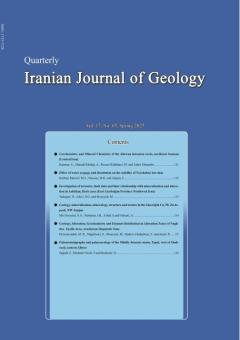Effect of water seepage and dissolution on the stability of Neyshabur bar dam
Subject Areas :M.T. Karbasi Maroof 1 , HamidReza Nasseri 2 , Farshad Alijani 3
1 -
2 -
3 -
Keywords: Bar dam, Dissolution of dam site, Seepage modeling,
Abstract :
Bar dam has been constructed in northwest Neyshabur city, off-stream Bar river to provide the urban drinking water and Neyshabur steel factory water demand, respectively. The water balance of the Bar dam has indicated 35-70% water seepage from the dam reservoir during six trial water intakes. The significant seepage, high concentration of solutes in the leaked water, impact on water resources planning and projected allocations threaten the stability of the Bar dam. Analysis of the observation wells hydrograph indicated major water seepage from the central part of the foundation of the main dam site and minor seepage from other areas. water seepage modeling using MODFLOW software showed that 75% of the volume of the leaked water passed through the foundation of the main dam site. Furthermore, the chemical analysis of the leaked water samples indicated an increase in total dissolve solids to more than 5 to 10 times, especially in the central and left areas of the dam reservoir. The amount of the dissolved material due to water seepage from the main dam site was calculated based on the data collected from the modeling of water seepage from the dam reservoir, results of hydrochemical sampling, time series analysis of the seepage rate, and mass balance of the dam reservoir water. Finally, the effect of dissolution on the increase of porosity was investigated and based on the results,the maximum annual development of porosity in the middle part of the main dam axis was about 0.06%.
اکبری، ف.، باقری، ر. و ندری، آ.، 1397. بیلان هیدروژئولوژیک تالاب برم شور در شهرستان هفتکل استان خوزستان. فصلنامه زمینشناسی ایران، 12، 48، 1-10.
محمودلو، م.، جندقی، ن. و صیادی، م.، 1399. تکامل هیدروشیمیایی و کاهش کیفیت آب رودخانه گرگانرود. فصلنامه زمینشناسی ایران، 14، 55، 129-145.
نبی¬زاده، ن. و جعفری، ه. 1400. تخمین تغذیه آبخوان مرزی سرخس با استفاده از مدل عددی. فصلنامه زمینشناسی ایران، 15، 57، 15-27.
شرکت آبپوی.، 1394. گزارش مطالعات رفتارنگاری و آببندی مخزن سد بار. وزارت نیرو، شرکت آب منطقهای خراسان رضوی، 20.
واعظی، ع. و اسماعیل¬نیا، ن.، 1394. تعیین لایه نشتی و بررسی مکانیسم نشت از تکیهگاه چپ سد آغ چای (آذربایجان غربی) با استفاده از مطالعات هیدروژئولوژی. فصلنامه مهندسی آبیاری و آب، 8، 30.
Bedmar, A. P. and Araguas, L. U. I. S., 2002. Detection and the Prevention of Leaks from Dams. CRC Press.
Craft, C. D., Pearson, R. M. and Hurcomb, D., 2007. Mineral dissolution and dam seepage chemistry–The Bureau of reclamation experience. In Proceedings of the 2007 National Meeting, Dam Safety 2007.
-Jixiang, H.U., Fuheng, M.A. and Jiang, H.U., 2018. Characteristics and evolution of seepage water hydrochemistry at dam-site on Lijiaxia hydropower station. Congres des Grands Barrages, Vienne.
Kimble, J. M., Knox, E. G. and Holzhey, C. S., 1993. Soil survey laboratory methods for characterizing physical and chemical properties and mineralogy of soils. In Application of Agricultural Analysis in Environmental Studies, ASTM International.
Li, X. Ye, S., Wang, L. and Zhang, J., 2017. Tracing groundwater recharge sources beneath a reservoir on a mountain-front plain using hydrochemistry and stable isotopes. Water Science and Technology: Water Supply, 17(5), 1447-1457.
McDonald M.G. and Harbaugh A.W. 1988. A modular three-dimensional finite-difference groundwater flow model. U.S. Geological survey Techniques of Water-Resources Investigation 6(A1). 586.
Mozafari, M., Raeisi, E. and Guerrero, J., 2018. Contribution of spectral coherency analysis and tracer test to study leakage at the Doosti Dam reservoir. Iran and Turkmenistan Environmental earth sciences, 77(4), 139.
Noble, J. and Ansari, M. A., 2017. Environmental isotope investigation for the identification of source of springs observed in the hillock on the left flank of Gollaleru Earthen Dam, Andhra Pradesh, India. Journal of Earth System Science,126(5), 67.
Piqueras, J. M., Perez, E. S. and Menendez-Pidal, I., 2012. Water seepage beneath dams on soluble evaporite deposits: a laboratory and field study (Caspe Dam, Spain). Bulletin of engineering Geology and the Environment, 71(2), 201-213.
Sammen, S. S., Mohamed, T. A., Ghazali, A. H., Sidek, L. M. and El-Shafie, A., 2017. An evaluation of existent methods for estimation of embankment dam breach parameters. Natural Hazards, 87(1), 545-566.
Sjodahl, P., Dahlin, T. and Johansson, S., 2008. Resistivity monitoring for internal erosion detection at Hallby embankment dam. In Progress in Environmental and Engineering Geophysics: Proceedings of the International Conference on Environmental and Engineering Geophysics, International Conference on E-Commerce E-Business and E-Government (ICEEG) Science Press, 310-316.
Ullah, A., Kassim, A., Alam, I. and Junaid, M., 2019 Efficiency analysis of seepage of Baz Ali small dam, Kurram Agency using clay blanket and cut off wall with sand filter, Journal of the Geological Society of Malaysia, 67, 113-118.
Unal, B., Celik, M. and Yıldırım, T., 2008. Evaluation of seepage problems of the Armagan Dam, Kırklareli, northwestern Turkey. Bulletin of Engineering Geology and the Environment, 67(3), 335-344.
Wang, S.W., Xu, Y.L., Gu, C.S. and Bao, T.F., 2018. Monitoring models for base flow effect and daily variation of dam seepage elements considering time lag effect. Water Science and Engineering, 11(4), 344-354.


